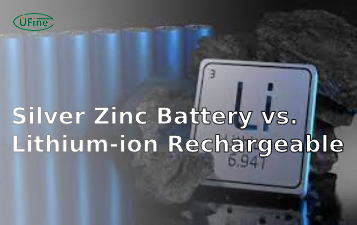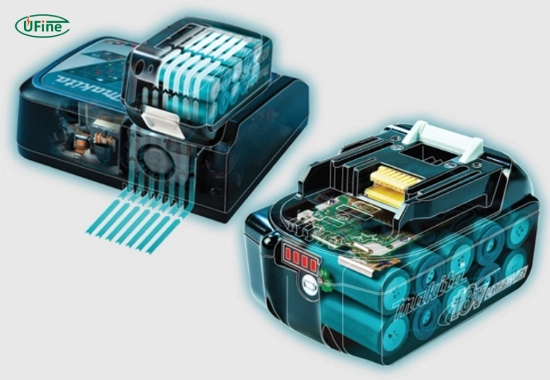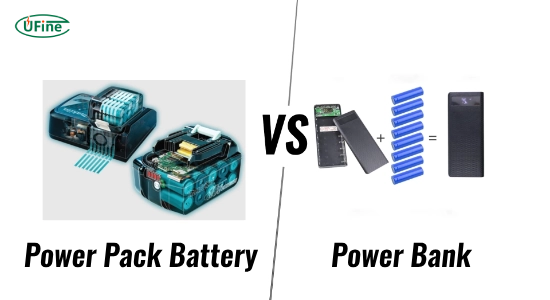
- Part 1. What is a power pack battery?
- Part 2. What is a power bank?
- Part 3. Key differences between a power pack battery and a power bank
- Part 4. Who should use a power pack battery?
- Part 5. When is a power bank a better choice?
- Part 6. Power pack battery vs. power bank: How much power do you need?
- Part 7. Power pack battery vs. power bank: Charging options and speed
- Part 8. Power pack battery vs. power bank: Portability and design considerations
- Part 9. Power pack battery vs. power bank: Durability, safety, and battery life
- Part 10. Price vs. performance: What’s worth your money?
- Part 11. FAQs about a power pack battery and a power bank
What’s the difference between a power pack battery and a power bank? A power pack battery is a high-capacity portable energy solution that can power multiple devices for hours or days, ideal for remote work, camping, or emergency use. In contrast, a power bank is a compact portable battery pack designed mainly for smartphones, tablets, and small electronics. Understanding these differences helps you choose the right device for your needs.
Part 1. What is a power pack battery?
A power pack battery is a high-capacity portable battery pack that can power laptops, mini-fridges, and other devices during off-grid living, remote work, or emergencies.
These batteries are often used in:
- Off-grid living
- Remote work locations
- Camping and RV trips
- Emergency power backup
Power pack batteries typically contain high-capacity lithium-ion or LiFePO4 cells, and often include multiple output ports such as:
- AC outlets (110V or 220V)
- DC carports
- USB-A and USB-C ports
- Solar charging input
Some even support wireless charging and smart app monitoring. Because they’re built for more demanding scenarios, they’re heavier, more expensive, and have longer recharge times.
Part 2. What is a power bank?
A power bank is a compact, portable device that stores energy to charge electronic devices on the go. Essentially, it is a portable battery pack for smartphones, tablets, Bluetooth headphones, and smartwatches.
- Smartphones
- Tablets
- Bluetooth headphones
- Smartwatches
These devices are designed for daily convenience. They are small enough to fit in your pocket or backpack and, depending on their capacity, usually provide 1 to 6 full phone charges.
Most power banks use USB-A or USB-C outputs, and some support fast charging with Power Delivery (PD) or Qualcomm Quick Charge (QC) standards. With their lightweight design, portable battery packs are ideal for travelers, commuters, students, or anyone who needs reliable charging on the go.
Because of their size and simplicity, power banks are ideal for:
- Travelers
- Commuters
- Students
- Anyone who needs to charge on the go
Part 3. Key differences between a power pack battery and a power bank
Before diving into the table, let’s explain the core differences in simple terms:
A power pack battery is like a mini generator. It’s built to power large devices or multiple gadgets simultaneously, often over several days.
A power bank is like a portable charger. It’s built for short-term, small-device charging, such as phones or tablets.
Now, let’s look at a real-world comparison based on typical specifications in 2024:
Comparison Table: Power Pack Battery vs. Power Bank
Here’s a clear comparison of a power pack battery vs a power bank to help you decide which portable battery pack fits your needs.
| Feature | Power Pack Battery | Power Bank |
|---|---|---|
| Battery Capacity | 100,000mAh – 240,000mAh (370Wh – 1000Wh) | 5,000mAh – 30,000mAh (18Wh – 111Wh) |
| Devices Supported | Laptops, drones, mini-fridges, CPAP machines, power tools | Smartphones, tablets, Bluetooth headphones |
| Output Ports | AC (110V/220V), USB-A, USB-C, DC, Carport | USB-A, USB-C (some with PD) |
| Recharge Time | 5 – 12 hours (AC or solar) | 1 – 4 hours |
| Size & Weight | 3 – 10 kg (6.6 – 22 lbs) | 150g – 600g (0.3 – 1.3 lbs) |
| Use Case | Camping, van life, emergency power, mobile workstations | Travel, commuting, daily charging |
| Solar Charging | Supported (on most models) | Rare or not supported |
| Price Range | $250 – $1,500+ | $15 – $100 |
| Lifespan (Charge Cycles) | 2,000 – 6,000 cycles (esp. LiFePO4) | 300 – 1,000 cycles |
| Air Travel Friendly? | Usually Not Allowed (>100Wh) | Yes, if <100Wh |
Part 4. Who should use a power pack battery?
A power pack battery is ideal for:
- Outdoor enthusiasts who need to power gear during multi-day camping trips.
- Remote workers or digital nomads who want to use laptops, monitors, and Wi-Fi routers off-grid.
- Emergency preparedness: Great for power outages, natural disasters, or blackouts.
- Van lifers and RV travelers who need off-grid power without a generator.
- Medical users need backup for CPAP machines or portable oxygen devices.
Choose a power pack battery if you want a serious power source that can keep multiple devices running for hours or even days.
Part 5. When is a power bank a better choice?
A power bank is perfect for:
- Daily commuters who want to charge their phone on the go.
- Students who need extra battery life for their phones or tablets during class.
- Travelers on long flights or road trips.
- Anyone who doesn’t want to be tied to a wall socket all day.
Choose a power bank if portability and simplicity are your top priorities. It slips into your bag and charges your phone wherever you are.
Part 6. Power pack battery vs. power bank: How much power do you need?
Quick Guide: Choose your portable battery pack
- Phones & Tablets: Power bank 5,000–10,000mAh = 1–2 charges
- Laptops & Larger Devices: Power pack battery 60,000–150,000mAh = 1–3 laptop charges
- Emergency/Off-Grid: Power pack battery 240,000mAh+ = Supports appliances, lights, fans for hours to days
Part 7. Power pack battery vs. power bank: Charging options and speed
Power banks usually charge via:
- USB-C (PD)
- Micro USB
- Wall outlet (5V/2A)
They recharge in 2–4 hours depending on capacity and charger speed.
Power pack batteries offer:
- AC wall charging
- Car charging (12V DC)
- Solar panel input (MPPT-supported)
- USB-C PD input/output
Recharge times vary from 5 to 12 hours depending on the method and wattage.
Part 8. Power pack battery vs. power bank: Portability and design considerations
Power banks are designed for maximum portability. Some models are smaller than a smartphone and weigh less than 200 grams.
Power pack batteries are built for capacity, not convenience. Even compact models weigh 3–5 kg, while larger units can weigh 15 kg or more.
However, many now have carrying handles, wheels, and rugged designs for outdoor use.
Part 9. Power pack battery vs. power bank: Durability, safety, and battery life
Power Banks:
- Often built with basic protection circuits
- Battery life: 300–1,000 cycles
- Prone to overheating if misused
Power Pack Batteries:
- Include advanced Battery Management Systems (BMS)
- Protection from overcharge, short circuit, and overheating
- Often use LiFePO4 cells rated for 2,000 to 6,000 cycles
- It can last up to 10 years with proper care
Investing in a long-term power pack makes a power pack battery more durable and safer.
Part 10. Price vs. performance: What’s worth your money?
Power Banks:
- Affordable: $15 – $100
- Good for casual users
- Best price-to-convenience ratio
Power Pack Batteries:
- Expensive: $250 – $1,500+
- Long-term investment
- Offers 10–30x more power than a standard power bank
- Can replace gas generators in some cases
Verdict: If charging a phone, stick with a power bank. Use a power pack to build a mobile or emergency power setup.
Part 11. FAQs about a power pack battery and a power bank
Can a power pack battery charge a phone?
Yes, most power pack batteries have USB ports and can charge phones multiple times, making them a versatile battery pack for phone users.
Is a power bank enough for camping trips?
For short weekend trips, a power bank works fine. For longer trips, a power pack battery or portable battery pack is recommended to power lights, fans, and devices.
Can I fly with a power pack battery?
Airlines usually restrict lithium batteries above 100Wh. Use a power bank under 100Wh for travel.
What devices can a 100,000mAh power pack support?
A power pack battery of 100,000mAh can power laptops, Wi-Fi routers, and mini-fridges for hours, perfect for remote work or emergency situations.
Which lasts longer: a power bank or a power pack battery?
Power pack batteries last longer both in daily usage time and long-term lifespan. Many offer 2,000+ charge cycles, while power banks usually last 300–500 cycles.
Related Tags:
More Articles

What is the Difference Between Silver Zinc Battery vs. Lithium-ion Rechargeable?
Compare silver zinc and lithium-ion rechargeable batteries: energy density, cycle life, safety, cost, and uses in drones, medical devices, EVs, and electronics.
What are Watts and Watt Hours in Battery?
Understand watt vs watt-hour in batteries: key differences, how to calculate capacity, and why they matter. Includes free comparison table.
Best 10 Blood Pressure Monitor Battery Review: Finding the Most Reliable
Are you looking for a reliable Blood Pressure Monitor battery? Here is a complete guide with the top 10 best blood pressure monitor batteries.
Bluetooth Headphone Battery Guide: All You Need to Know
Maximize headphone battery life with expert tips! Learn how to charge, check, troubleshoot, and choose the best bluetooth headphone battery in 2025.
LiFePO4 Battery VS. Lithium-ion Polymer Battery: Which One Is Best?
Comprehensive comparison of LiFePO4 vs Lithium Ion Polymer batteries: energy density, safety, lifespan, cost. Find out which battery suits your needs in 2025.





